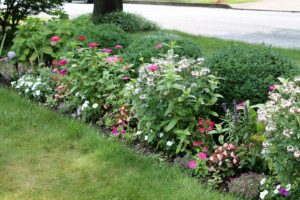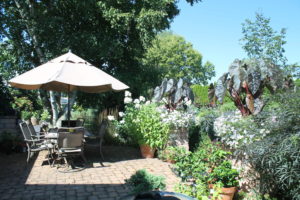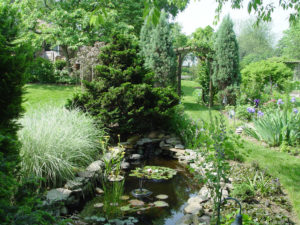A Virtual Tour of Our Endangered Gardens
October 16th, 2018
Now that my wife, Sue, and I are in the process of relocating to the Pittsburgh area, we’ll be selling our Hampden Twp. house.
We’re not sure what that means for the gardens we’ve built and tended for the past 32 years. It’d be great to find a plant-loving buyer (call me at 717-737-8530 or email george@georgeweigel.net if you’re interested or know someone who is), but if that doesn’t work out, it’s entirely possible the gardens could be gutted to make way for more lawn.
Given that possibility, I’m snapping pictures and planning to take along a few of my more beloved and/or special plants. Fellow already-relocated gardener Cristina Papson also suggested that I take along a vial of garden soil, sort of a keepsake similar to saving ashes from a deceased loved one.
Some of you have seen our gardens first-hand during the two times they were on Penn-Cumberland Garden Club tours. For others, I thought this might be a good time to do an online “virtual tour” so there’s something left behind if a gutting happens.
To see 33 photos from around the yard, head to my website’s Photo Gallery section and check out the one on George and Sue’s Gardens.
To read about more details on our house/gardens if you’re a potential buyer, see my post on “We’re moving. Want Our Gardens?”
Our gardens really are more horticultural test lab than anything. They aren’t what I would have designed if I were trying to come up with a really nice layout.
Instead, I sacrificed design for what’s more of a mash-up of onesies and twosies in order to see what these plants do in the real world of central Pennsylvania’s weather, climate, soil, and animal assemblage. With only a third of an acre to work with, I didn’t have the luxury of carving out big test beds for research purposes, separate from the “real” landscape.
Over the years, I’ve constantly planted new introductions and plants worth trying. That gave me first-hand experience with just about anything worth growing in this area as well as specimens to photograph for my writing work.
One source of plants has been growers, who often give garden writers samples of their new intro’s in return for feedback on how the plants performed. For growers, it helps produce field results from impartial gardeners in a variety of growing regions.
The down side is you never know what you’re going to get. I often walked the yard in spring with new plant in hand, trying to figure out where to cram it without totally disrupting the existing layout.
I’ve learned that new doesn’t always equate with better. In fact, a lot of new introductions weren’t any better than existing plants… or showed an improvement in one area while taking two steps back in other areas.
In thinking back, it’s boggling how many of my supposed “new and improved” plants died, got yanked because of poor performance, or just disappeared after a year or two of decent performance.
Plants good enough to earn a keep in my garden (both bought and test ones) have moved around two or three times. Hardly anything is where I originally planted it.
I’ve played “musical plants” for years, transplanting keepers to replace the die-ers and just redesigning beds that were becoming jumbled messes due to the constant insertion of onesies and twosies.
Given the difficulty of designing this way, I think the gardens came out reasonably well. At least I like them, which is what really counts anyway.
The look might not cut muster with Garden Design magazine, but it is an interesting collection of gardens that make some fun gawking for hortiholics.
The front started out as a basic green lawn with a sugar maple tree and a leaning purple-leaf plum. A forsythia was at the front corner, and boxed-off yews lined the front foundation. Boring.
The maple died (climate got too hot for sugar maple), I yanked the plum and forsythia (hurting my back in the process), and I carved two yews into topiary shapes while yanking the others.
Over the years, we added a boxwood-lined, front-sidewalk garden that has several specimen shrubs and a mix of annuals to give a sort of “meadowy” look with lots of color.
We also expanded the front foundation, replaced the skinny concrete sidewalk with pavers, and added a garden of roses, catmint, boxwoods, and lilies to a paver-bordering garden that’s also anchored with a Rutgers hybrid ‘Aurora’ dogwood tree.
We turned the morning-sun eastern foundation into an Asian shade garden with primarily warm colors (gold, yellow, burgundy, red). The property border also ties into that theme so that that whole side of the house is gardens with a grass path winding through it.
Along the afternoon-side western foundation, we planted a few more roses, a variety of changing sun-loving test plants, and one of my favorite plants in the yard – a hardy fig that I’ve espaliered up the brick garage wall there.
Along the back of the house, we installed a paver patio with waist-high side walls and a pair of columns over top of what originally was a small, square, concrete slab of a patio that was lined with a yew hedge.
That was our biggest and best improvement. It’s a great place to sit and oversee the “plantation” below. I edged the patio in more interesting plants such as a Black Lace elderberry, a trio of Knock Out Pink roses, and a pair of summer-blooming panicle hydrangeas, plus a selection of test annuals and perennials.
We’ve always loaded up the patio with pots and planters, too.
A big chunk of the back yard (about 25 feet square) is devoted to my raised-bed vegetable gardens. Vegetables were my first plant love, and they’re still the last plants I’d give up. Deutzias are nice, but I like a fresh tomato more.
The vegetable garden used to be bigger and more geared toward maximum production with longer beds and palace-like split-rail fencing. When the kids grew up and left, Sue and I didn’t need as much food, so I converted it to a more ornamental four-square-like design.
In the back right corner of the yard, we added a kidney-shaped water garden with falls, tucked under the big branches of a wild cherry tree that’s actually my neighbor’s. (Sadly, it’s now dying.)
I planted a viburnum back there for screening years ago, and we also have an A-frame swing that’s perfect for sitting in the shade and watching the water drop.
The water garden is surrounded by a pair of big beds that are planted with a mix of shrubs, evergreens, and perennials. It’s another area where I’ve tucked in and torn out test perennials and annuals each year.
I designed this area so that you enter it through an evergreen-flanked, vine-covered arbor to give the effect of a doorway into a secret garden.
Along the right side of the back yard, I planted an island bed that originally was home to my fruit trees. I gradually replaced them with ornamentals since it’s so hard to grow tree fruit without constant spraying.
The kicker for my last peach tree was when I was about to harvest a decent crop one July but found a groundhog up in the tree eating the nearly ripe fruit right off the branches.
Now this bed has an American fringe tree, a beautiful Japanese umbrella pine (one of my favorite conifers), a dwarf ginkgo, one hanger-on apple tree (a supposedly disease-resistant type called ‘Liberty’ that gets hammered each year by rust anyway), and a rare gordlinia, which is an intergeneric cross of gordonia and franklinia (themselves both unusual trees).
Along the right back property line, I have a Dragon Lady holly, a panicle hydrangea that I pruned into a standard, and a variety of part shade perennials. It used to be my blue-plant garden (a failed concept) and before that was a perennial border.
I fenced that border years ago when neighbors split up and moved out abruptly, leaving an abandoned house for two years. That’s when I learned that some supposed “turfgrasses” can grow shoulder-high when not mowed.
The left-side back border is where I grow seven blueberry bushes (they’re ornamental as well as tasty and fairly easy to grow) along with a threadleaf falsecypress, a dark-leafed ninebark, and a trellis-shaded sitting area that’s flanked by a pair of blue hollies.
I do have some grass, but most of it functions like the paths through the network of garden beds.
Enjoy looking at the pictures in my Photo Gallery. And if you know of any home-buyers in the market for a place with a whole lot of plants, have ‘em contact me at 717-737-9530 or george@georgeweigel.net.













